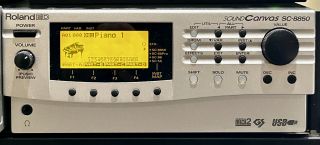Roland-ED SC-8850
 |
|
| W × H × D (mm) | 218 × 88 × 278[1] |
|---|---|
| Rack units | 2U, half-width |
| Type | GM/GM2/GS sound module |
| Manufacturer | Roland-ED |
| Release date | 1999 |
| Standards | General MIDI General MIDI 2 Roland GS |
| Parts | 64[infobox 1][2] |
| Max polyphony | 128[1] |
| Normal presets | 1640 + 256 user presets[1] |
| Drum presets | 63 + 2 user presets[1] |
| Effects | Reverb, Delay, Chorus, Two-Band global EQ, Global insertion FX based on BOSS effect units. |
| ← Roland SC-88 Pro | |
|
|
The Roland-ED SC-8850 is a Sound Canvas unit released in 1999, notable for being the first synthesizer to support the General MIDI 2 standard as well as MIDI via USB.[3] It is the successor to the Roland SC-88 Pro. It is also the first Sound Canvas device to feature up to 4 voices per note, 64 individual parts (grouped in 4 pairs of 16), as well as 128 voice polyphony. It can channel 32khz 24bit sound to two separate sets of RCA outputs (selectable per MIDI channel via the onboard panel and SysEX), and has a pair of RCA inputs as well for passing through computer audio.
When connected to USB, the MIDI IN and MIDI OUT jacks act as a MIDI Interface for other instruments.
Two later versions based on this were made, the Roland-ED SC-8820 and the Roland-ED SC-D70 - they feature the same sample map as the 8850, but with a smaller sample ROM, up to 32 parts, up to 2 voices per note, and only 64 voice polyphony - all similar to the Roland SC-88 and SC-88 Pro that came before.
A VST version, called Sound Canvas VA was released in 2015 - based on the SC-8820. This version was first released standalone, then included with the Roland Cloud software-as-a-service subscription. This iteration is further limited to only 16 parts. This was discontinued on the 1st of September 2024, where it was no longer available for purchase.
Power requirements
The SC-8850 is unique in that it has a built-in transformer that supports voltages from 100 V to 240 V, 50~60 hz. This makes the device universal, meaning it can be powered in any territory straight from mains. The connector on the unit is a figure-8 type, found on other electronics like TVs, printers, Sony PlayStation and Microsoft XBOX consoles, and more.
Oddities
Filter and map compatiblity issues
The SC-8850 is a completely new iteration on the Sound Canvas, much like how the SC-88 was to the SC-55 - this means that while MIDIs designed for prior iterations should work fine, the new engine will mean that aspects, notably the cutoff and resonance controls can be very off. The samples used for the SC-55 map can also be completely wrong at times, not matching the samples used on the actual unit, despite the real samples being present and used in other patches and kits. Note choking (used for effects like choked cymbals in DOOM's "At Doom's Gate", for example) will also not work.
USB Ground noise
The USB port on the unit is unshielded, which is likely a design failure from being the first USB synthesizer. This means the unit's sound output is susceptible to ground loops. A way around this is to use a high quality power lead, as well as a high quality USB cable with ferrite chokers on each end. Another way is to forego the use of USB altogether and use it via MIDI or Serial instead.
Saving and loading
Prior Sound Canvas devices would save your settings when power was disconnected via the use of a CR2032 battery inside the unit. The SC-8850 no longer features this battery, instead opting to use flash memory. This means that you need to explicitly save your part settings before turning the device off, and explicitly loading them when resuming song making. Another way to do this is to transmit a bulk dump via SysEX. This can be set to load from the user memory instead, making it behave more like original units.[4]